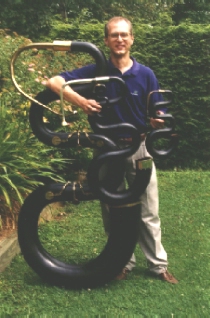| The serpent is the distant ancestor of today's
tuba, and was popular around 1600 to 1850. It forms the natural bass
to the cornett family, having a conical wooden bore and fingerholes, with
a brass-style cup mouthpiece. The serpent, like the cornett, has
a very "flexible" intonation: the fingerholes are positioned more as a
matter of convenience for fingering than for acoustic usefulness.
Sounding a precise pitch requires a good ear and well-practiced embouchure
- the fingering helps, but doesn't restrict the pitch the way it would
on a modern woodwind instrument. Thus, a favorite stunt for serpent
players is to finger a descending scale while sounding an ascending scale
(and vice versa).
Serpents are traditionally carved from wood in two halves, which are then glued together and wrapped tightly in leather. Modern reproductions are also available made from resin (aka plastic). |

Douglas Yeo, with contrabass, bass, tenor, and soprano serpents. Picture used with permission |
| Serpents were made primarily in two forms: the "church" serpent (those pictured here), and the "military" serpent, which is intended to be held sideways (for playing on horseback). The main difference is probably that the right hand is in a different position, so that the fingerings for that hand are reversed. Serpents were mainly made to sound in 8' C or Bb, although the rare contrabass serpent (in 16' C, sometimes called the Anaconda) was sometimes encountered. | The serpent was eventually replaced by the ophicleide (whose name means "serpent with keys"), which has a conical metal bore, and large tone holes in acoustically useful (approximately) positions. Both were then rendered obsolete by the modern tuba. |
| The greatest modern exponents of the serpent today are probably Douglas Yeo (bass trombone, BSO) and Michel Godard (La Fenice, Loose Wires). | See also the Serpent Website for additional information, pictures, sound clips, links, and more. See Christopher Monk Instruments for serpents in any size, including the anaconda. |